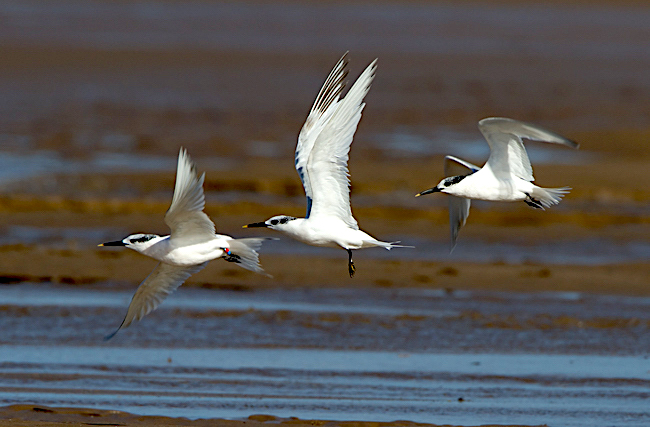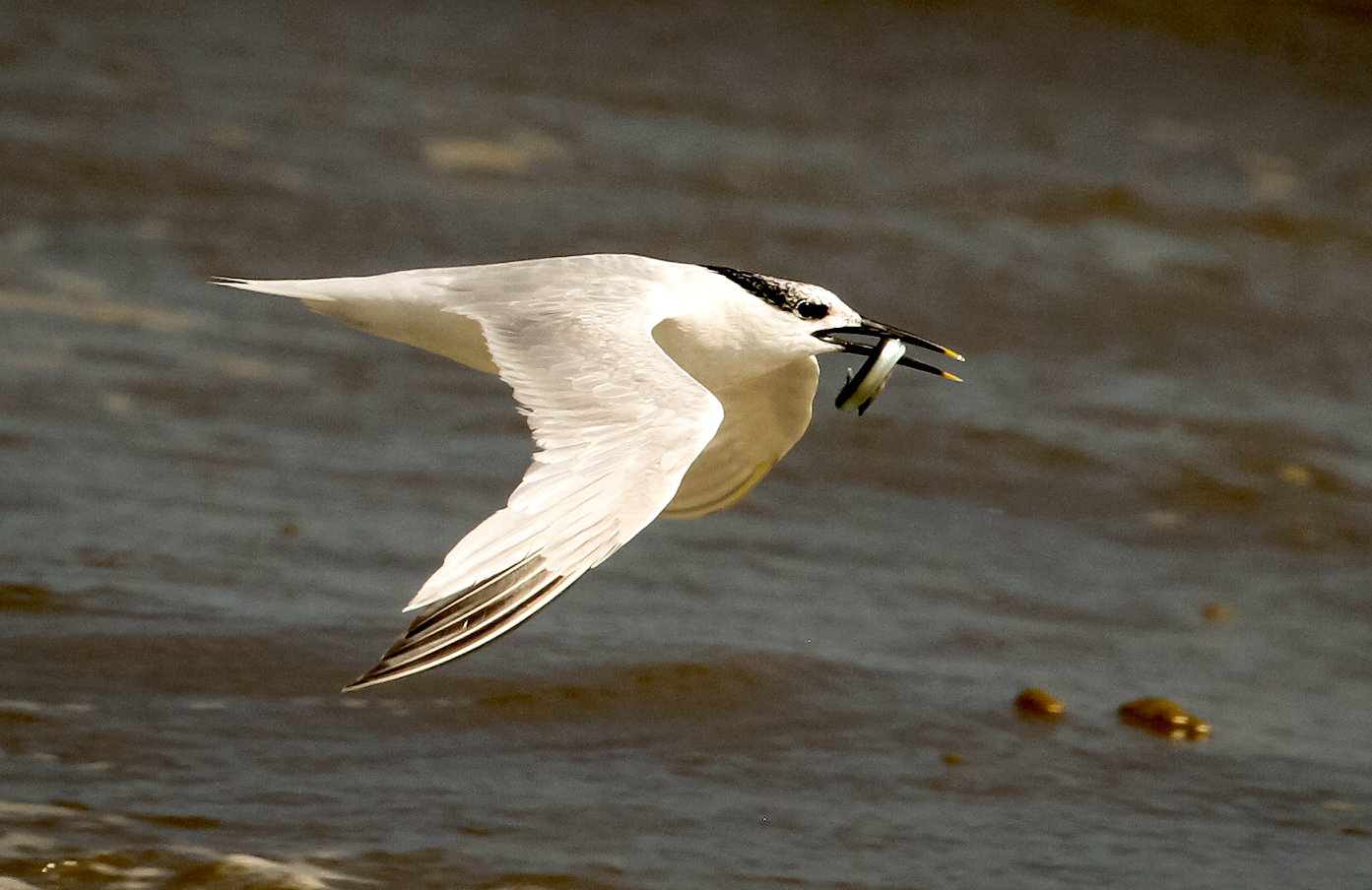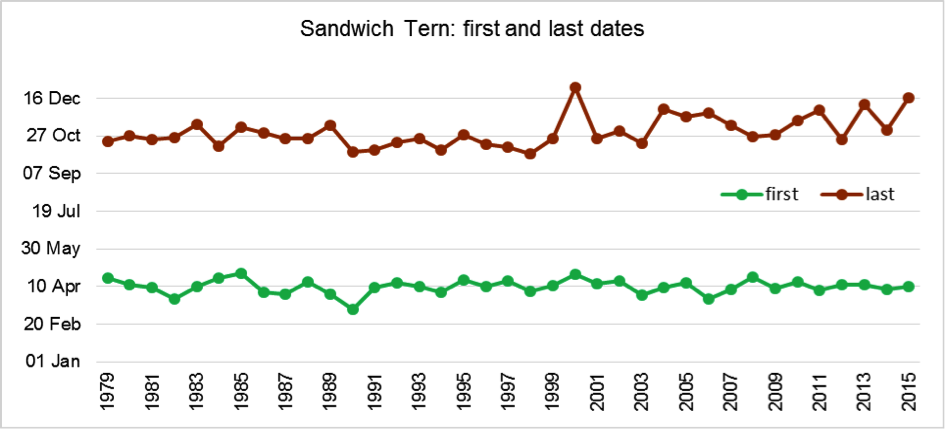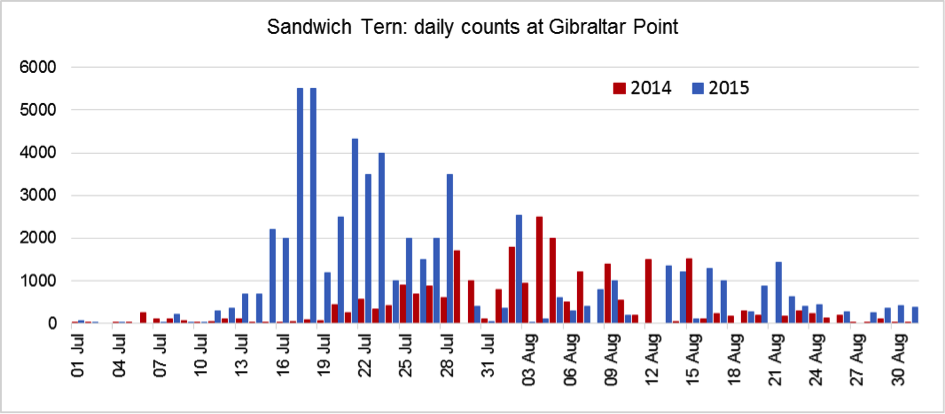Sandwich Tern Sterna sandvicensis


Barely qualifies as an irregular Lincolnshire breeder on the basis of six pairs that nested in a Common Tern colony at Friskney in 1950 but failed to raise any young. Although they breed close by in large colonies on the Norfolk coast at Scolt Head Island and Blakeney Point, the Lincolnshire coast appears to be too disturbed for them. However, the large numbers that use the coast from North Cotes to Gibraltar Point in July–August, bringing their recently fledged young to feed here, suggests there is no problem with food availability. Peak counts reported in LBR 2014 – 2018 were 800 in the north at Saltfleet/Mablethorpe in August 2016 and in the south 5,500 at Gibraltar Point in July 2015. Colour ringed birds from the Blakeney Point colony are regularly recorded at Gibraltar Point. There have been several exceptionally late records: December 8th 1959, December 9th 2013, and the latest ever at Witham Mouth on December 30th 2000. There is also one January record at Witham Mouth, on 19th January 2012. There has been a trend recently for the last dates to be later than previously, as shown in the table and chart below. Excluding the January 2012 record, the averages for three 12-year periods have been:


In autumn, the largest counts are at Gibraltar Point with roost counts regularly exceeding 1,000 birds. Birds feeding or roosting in the area dominate many counts but there is also a pronounced southerly movement. In 2016 the estimated total of birds passing through Gibraltar Point in July-September was 10,149; numbers fell quickly at the very end of September that year, and there were only single figure counts from October 5th onwards with a few right to the end of that month. Stragglers were noted into November with three moving north there on November 1st. All in all, this is illustrative of a fairly typical year. The chart below shows the daily counts at Gibraltar Point in 2014 and 2015 and contrasts the lower numbers and later peaks seen in 2014 with a more typical year in 2015.

Birds from the different Sandwich Tern colonies in Western Europe all belong to a meta-population that is able to quickly respond to changing breeding conditions by moving between colony sites. Post-breeding Sandwich Terns disperse throughout the coastal areas around their breeding colonies and to neighbouring countries before migrating to the African wintering areas. British Sandwich Terns often cross the North Sea to visit Dutch, German and Danish coastal waters and many Dutch and Belgian Sandwich Terns first migrate to the UK or to Denmark (Fijn R.C., Wolf, P et al 2014).Historically there have been several autumn recoveries in the county of young birds ringed at east coast colonies in Aberdeenshire, Northumberland and Norfolk. One ringed in Germany in June 1964 was in the Wash in early September of that year and a nestling ringed in County Down in July 1972 was found dead at Grimsby in June 1983. One ringed in the Wash in August 1980 was found dead in France in April 1986, and another ringed in the same area in August 1984 was found dead in Kent a month later. An example of a more contemporary control identified by its colour rings is bird DS14898, which was ringed as a nestling in June 2013 in Norfolk:
DS14898
Nestling, ringed on 19-06-2013 at Blakeney Point: 52°58'N 0°58'E (Norfolk).
Seen alive (colour rings seen) on 27-08-2015 at Coquet Island: 55°19'N 1°32'W (Northumberland), 311km NNW (2 years 2 months and 8 days old)
Seen alive (colour rings seen) on 31-08-2016 at Gibraltar Point NNR: 53°5'N 0°18'E (Lincolnshire), 47km WNW (3 years 2 months and 12 days old).
Reference
Fijn, R.C., Wolf, P., Courtens, W., Verstraete, H., Stienen, E.W.M., Iliszko, L., and Poot, M.J.M. (2014). Post-breeding prospecting trips of adult Sandwich Terns Thalasseus sandvicensis. Bird Study 61, 566-571.
